- Stocks advanced, rotating on changing perceptions, which can flip again
- Friday's Nonfarm Payrolls release could determine next market direction
Volatility plunged last week, though that may not be the case in the upcoming week as markets await Friday's key, June Nonfarm Payrolls report. As well, investors increased demand for value stocks while dumping Treasuries, thereby boosting yields.
Reflation Trade Redux?
After recently losing momentum, equities tied to the recovery are back in fashion. A week ago we made the case that growth shares have dominated markets this year, despite the continuous chatter about the Reflation Trade. In last weekend's post, we demonstrated over every time frame during 2021 that there has been no cyclical rotation—proving that it ended in 2020.
However, the Fed moving ahead its timeline for interest rate hikes sent the market into a frenzy. Volatility accelerated, and now that the dust has settled, we find the balance between growth and value has shifted.
The newest market narrative is saying the Reflation Trade was dominant this year. To be fair, it’s difficult to make one calculation and accordingly reach firm conclusions, considering the various value sectors and numerous drivers they have. Growth has indeed outperformed value up to this point, but cyclical stocks have begun to rotate again.
On Friday, Financials added 1.2% of value. Lenders by definition would benefit from higher interest rates. Bolstering the case for a pivot back to the Reflation Trade, Technology stocks were the ones in the red, slipping 0.1%. Communication Services shares were little changed, up 0.1%.
For the week, the Tech and Communication Services sectors rose 2.2% and 3.3% respectively. That's half of the acceleration seen by of Financial and Energy shares which advance, +4.8% and 5.6% respectively on a weekly basis.
Of course, the Energy sector is influenced by a variety of catalysts, such as anticipated summer travel after lockdowns, the path to green energy and negotiations with Iran. Still, overall, Energy’s fate is generally tied to economic activity, which is only amplified after an economic shutdown.
Materials stocks were also playing according to their own tune last week, after having shot up to new records. Traders cashed out of the sector, pushing prices lower by 5.2% in the past month. Still, that should not be taken as an indication that the Reflation Trade is losing steam—on a YTD basis, Materials shares still outperformed Tech stocks.
Continuing the comparison of sector performance this year: on a three-month timeframe, value and growth were about equal, with Financials gaining 9.1%, Energy climbing 12.5%, while Technology added 12.25% and Communication Services put on another 10.3%. On this time horizon there's a kind of symmetry on the market balance between growth and value, about halfway into 2021, which finally brings us to the year-to-date view—which is where we see the sharpest reversal in fortunes since just last year.
While returns on Technology stocks on a YTD basis were +11.7%, all the classic value sectors bested that figure: Materials rose 13.5%, Industrials added 15.6%, Financials rallied by 25.25% and, finally, Energy shares racked up a whopping 46%. Even considering Communication’s Services’ 19.5% YTD gain, that's still lower than Financials and less than half of Energy’s returns.
After such a dramatic change in just a week, it's worth asking, what's the cause? Bloomberg provides the market narrative answer:
“At least for now, there’s a perception that officials won’t rush to boost interest rates despite mounting inflation pressures.”
Maybe. But the thing about such statements is, market chatter keeps shifting. So much so that investors have come up with opposite explanations for the same phenomena, even when nothing actually changed.
As best as we can tell, it’s a combination of markets moving as a herd, as traders convince each other of the latest narrative. Hopefully underneath all that noise is the core, smart money, which most of the time knows what it's doing. We’re just trying to identify that amid all the fallout.
Along with last week’s jump in stocks, investors sold off Treasuries, driving yields, including for the 10-year benchmark note, higher. But, we’re not impressed.
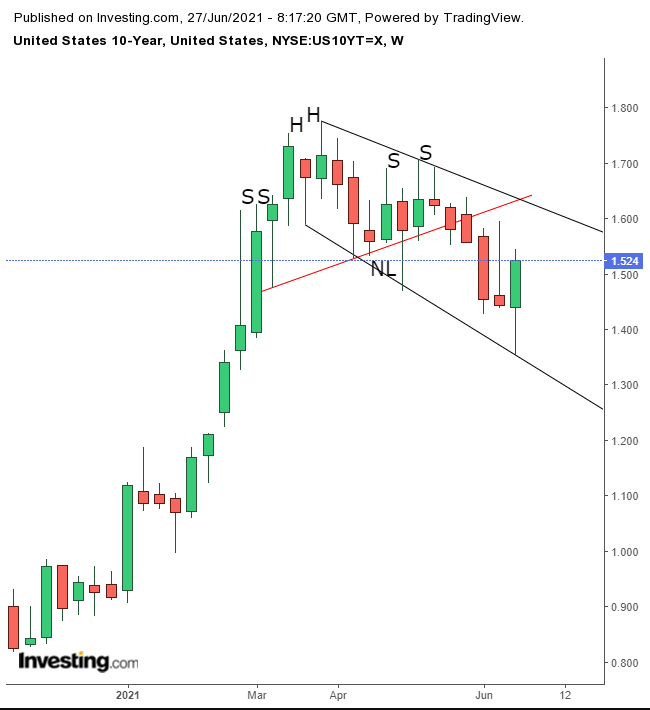
Rates have jumped, bouncing off the bottom of a falling channel after the previous week’s inverted hammer, after completing a H&S top. As far as we’re concerned, this is a return move, before yields continue their track lower, for now.
Indecision regarding what to make of the Fed, its rhetoric and the path to higher interest rates, along with the central bank shrinking its bloated balanced sheet on one side, while a powerful economic recovery is in the making after the biggest economic disruption in modern history, on the other side, is taking a toll on the dollar’s trend.
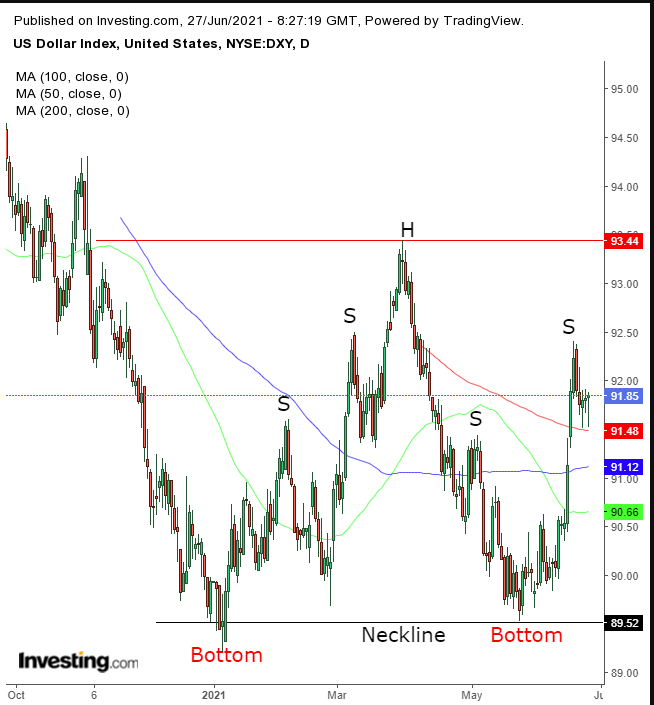
The greenback is trapped within a range, with the potential for a large H&S Continuation pattern on one side, and a Double Bottom of an equal scale, on the other. The direction of the breakout will likely determine the next medium-term move.
The same conflict on the other side of the dollar trade is visible vis a vis gold.
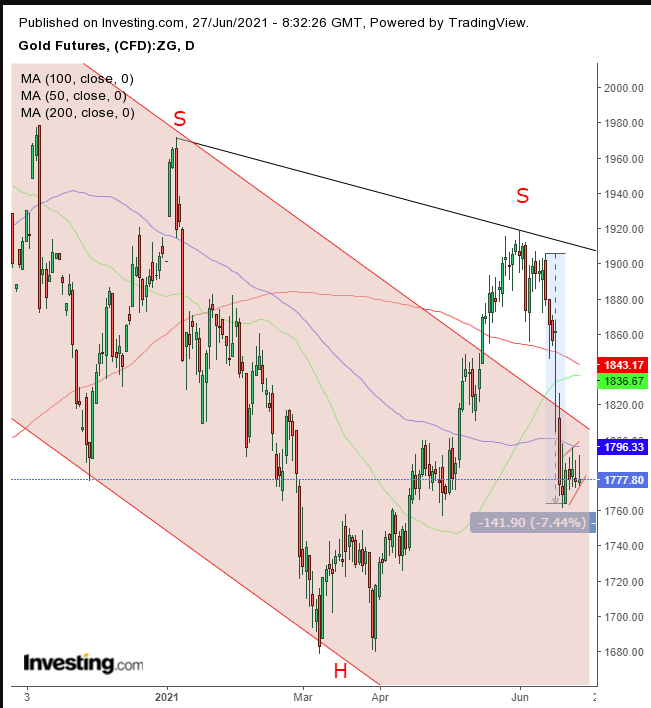
Is gold forming a large H&S bottom, or will the rising flag that developed last week, after the sheer drop that lost almost 7.5% of value, play itself out with a downside breakout, extending a second slump toward the bottom of the falling channel, testing the March low?
After losing 9% last week, Bitcoin was rising on Sunday, for the second weekend day. Still, longer term it, doesn’t look good for the cryptocurrency.
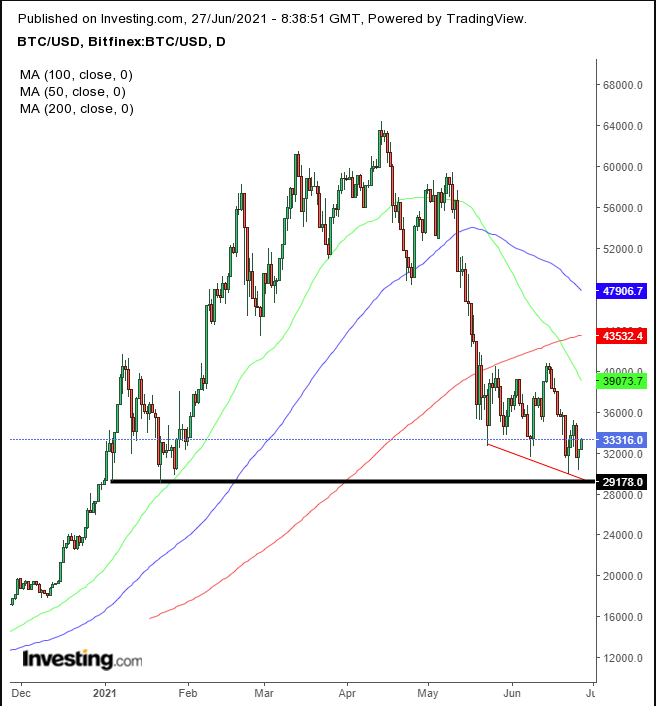
The digital token may be developing a H&S continuation pattern, which may have included a Death Cross. A downside breakout would complete the bearish pattern, within a downtrend, which if successful, would take out the $29,000 support, signaling an additional drop.
Oil has been unable to take on the $74 level, even after breaking through an Evening Star.
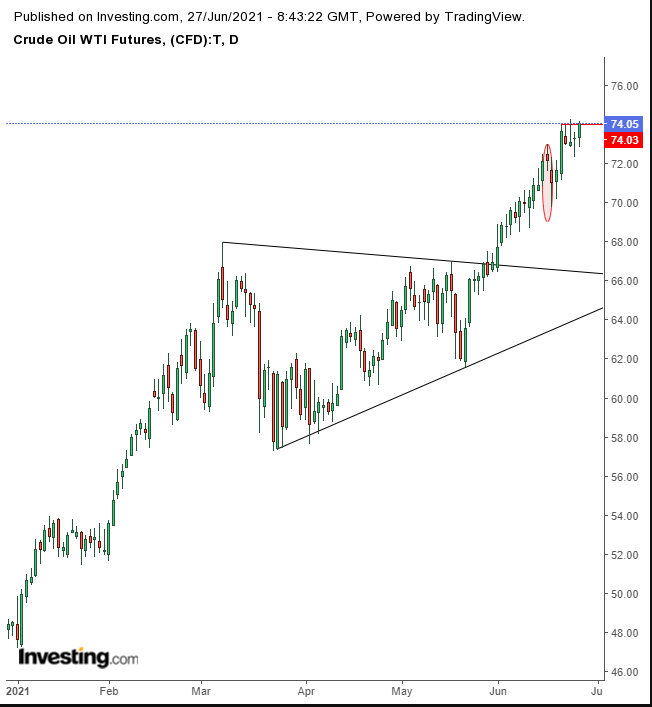
This suggests there's still WTI supply to clear, or the price may have to retest the bullish triangle.
The Week Ahead
All times listed are EDT
Tuesday
10:00: US – CB Consumer Confidence: expected to rise to 119.0 from 117.2.
21:00: China – Manufacturing PMI: seen to edge down to 50.7 from 51.0, nearing expansion/contraction line.
Wednesday
2:00:UK – GDP: anticipated to remain flat at -1.5% QoQ and -6.1% YoY.
3:55: Germany – Unemployment Change: seen to fall further, to -16% from -15%.
5:00: Eurozone – CPI: expected to edge lower YoY, to 1.9% from 2.0%.
8:15: US – ADP Nonfarm Employment Change: forecast to have plunged to 600K from 978K.
8:30: Canada – GDP: forecast to slide to -0.9% from 1.1% MoM.
10:00: US – Pending Home Sales: likely to leap to -1.0% from -4.4%.
10:30 – Crude Oil Inventories: last week showed a drawdown of 7.614M Bbl.
19:50: Japan – Tankan Large Manufactures Index: to triple to 15 from 5.
19:50: Japan – Tankan Large Non-Manufacturers Index: to surge to 3 from -1.
21:45: China – Caixin Manufacturing PMI: seen to retreat to 51.8 from 52.0.
Thursday
3:55: Germany – Manufacturing PMI: expected to edge higher to 64.9 from 64.4.
4:30: UK – Manufacturing PMI: seen to remain flat at 64.2.
8:30: US – Initial Jobless Claims: anticipated to decline to 386K from 411K.
10:00: US – ISM Manufacturing PMI: predicted to edge down to 61.0 from 61.2.
15:00: UK – BoE Gov Bailey Speaks
Friday
8:30: US – Nonfarm Payrolls: forecast to rise to 675K from 559K.
8:30: US – Unemployment Rate: likely to slip to 5.7% from 5.8%.
8:30: Eurozone – ECB President Lagarde Speaks
